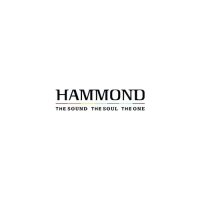1-6.
HARMONIC
DRAWBARS. -The
left group
of seven
harmonic drawbars (Figure
1
—8)
is
associated with
the lower
manual,
and
the right
group of nine
drawbars
controls
the
upper manual. By sliding
these drawbars
in and
out,
the organist
is
able
to
mix the
fundamental and
harmonics (or
overtones)
in
various
proportions. The distance a
bar
is
pulled out determines
the strength
of
the
corresponding harmonic; and if
a
drawbar
is set
all
the
way in, the
harmonic
it
repre-
sents
is not present
in
the
mixture.
Neither
manual will play unless one
of
its
drawbars
. is pulled
out at least part
of
the way
with
the drawbar
tab
pressed, or
a
preset tab is
pressed.
The
drawbars
sUde
over
1
7
busbars,
repre-
senting intensity levels. As
the drawbar
moves, its contact is
touching
some
busbar
at all times,
and
therefore
there
is a smooth
change
in volume
of
that
harmonic.
These
busbars
extend the length
of
the
draw-
bar
assembly,
and
are connected
to
the
low
impedance
primary of
a matching
transformer. Signals
from
the
high
imped-
ance secondary
of
this
transformer go
to
the preamplifier input. The matching
transformer
is
located
within the preampli-
fier chassis.
1-7-
PEDAL DRAWBAR.
-
The center drawbar
adjusts the volume
of
the
pedals. Its
opera-
tion is similar to that
of
a manual drawbar.
1-8.
PEDAL
KEYBOARD.
-The
13
playing
pedals
are operated
by the
left
foot
and
are
con-
nected
to the
lowest
1
3
frequencies
of
the
generator.
Like
the
manuals, they have
light and
dark
keys
arranged in
the standard
octave
pattern. Figure
1
—9
identifies
the
pedals and
shows
the
generator
frequency
number
associated with
each. A
single
contact
on each pedal
closes
when
the
pedal
is pressed,
thereby
allowing the
correct
generator
frequency
to reach
the amplifier.
1-9.
EXPRESSION PEDAL.
-
The expression
pedal, sometimes called
"swell" pedal
(Figure
1-1)
is
operated
by
the player's
right foot and
varies the volume of
both
manuals and pedals together.
When the
pedal
is tilted back
(closed) by pushing on
the
player's heel
the music
is
softest,
and
when pushed forward (opened)
by the
player's toe
the music is loudest.
Figure 1
-8.
Drawbars &
Control
Tabs
(Partial
View)

